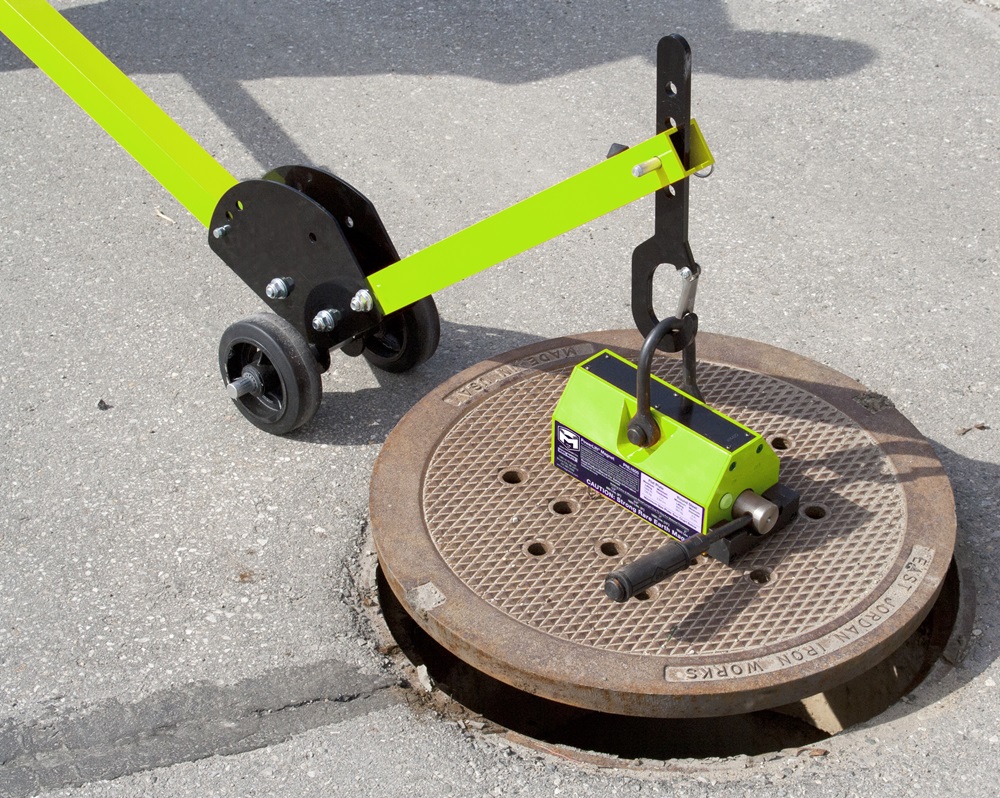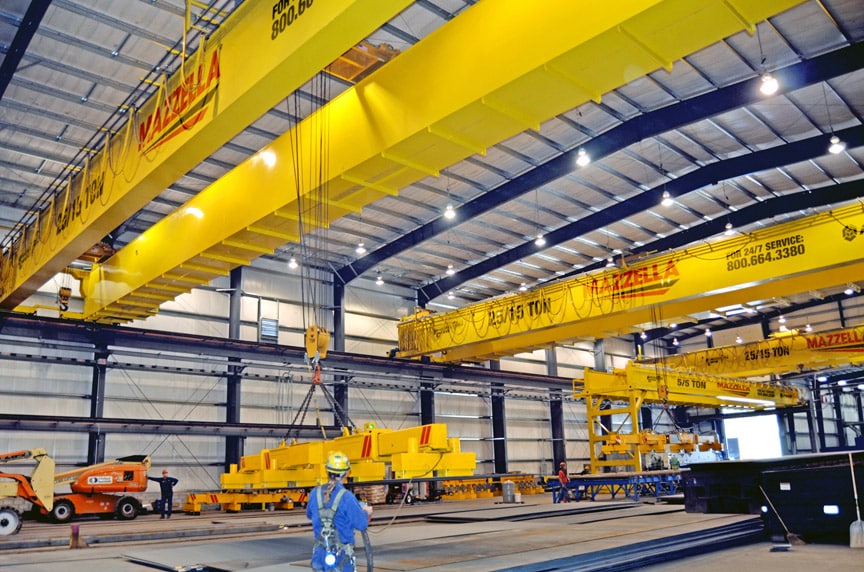What are Lifting Magnets, and How to Choose the Right One for Your Business
Learn how lifting magnets work, the differences between permanent, electro, and electro-permanent types, and how to choose the right one for your operation.
If your operation relies on moving large or heavy steel components, few tools are as valuable as a lifting magnet.
Whether you’re handling plate, bar, beam, or fabricated assemblies, magnetic lifters can simplify the job and make life easier and safer for workers. They also remove the need for chains, slings, or clamps that must be positioned underneath or around the part.
The result is faster setup, greater control, and fewer opportunities for injury or product damage.
However, many people are not familiar with lifting magnets and would rather opt for more traditional below-the-hook lifting devices. Do magnetic lifters make sense for your business? How do they work? Even if you know about lifting magnets, which type should you choose?
We will answer these questions, and more, in this article:
- What lifting magnets are, and how they are used
- The different kinds of lifting magnets
- Key factors to consider when choosing a magnet
- How to measure ROI for lifting magnets
- Typical price ranges for lifting magnets
What Is a Lifting Magnet?

A lifting magnet (also called magnetic lifters) are a below-the-hook device designed to pick up materials using a magnetic field. When the magnet engages the steel surface, it creates a powerful attraction that holds the load securely during lifting or positioning. Because the magnet connects from above, it eliminates the need for operators to reach under suspended materials or work in pinch points.
Magnets are commonly used in steel service centers, fabrication shops, heavy equipment manufacturing, and construction yards.
They excel in tasks such as moving plates from cutting tables, transferring steel components between workstations, or de-stacking sheet material where clamps and slings would slow production. They are also commonly used by construction firms and public utility companies to move manhole covers.
They can also be found at workstations in manufacturing facilities, helping workers assemble products with minimal manual labor.
Application Example: Coil Handling
In steel coil warehouses, operators often use C-hooks to lift coils through the eye. While effective, this method requires significant spacing between coils to insert and remove the hook safely. Magnetic coil lifters attach to the top of the coil instead, allowing coils to be stored closer together and reducing the amount of required floor space.
This approach also minimizes handling damage and improves worker safety by keeping personnel clear of pinch points and suspended loads.

Types of Lifting Magnets
Three primary magnet types are used for material handling: permanent, electromagnetic, and electro-permanent. Each has its own operating method and benefits.
Permanent Magnets
Permanent magnets use an internal magnetic field to lift without any external power source. They are turned on or off with a manual handle and provide consistent holding strength even during a power failure. Their simplicity and reliability make them ideal for general shop use, moderate capacities, and facilities that may not have electrical power at the lifting point.
Electromagnets
Electromagnets create a magnetic field when electrical current flows through coils inside the device. Turning the current off releases the load. Because the magnetic field strength can be precisely controlled, these magnets are common in automated or high-capacity systems. However, they require constant power to maintain hold, and without a battery backup, a power loss can release the load unexpectedly.
Electro-permanent Magnets
Electro-permanent magnets combine both technologies. A short electrical pulse magnetizes or demagnetizes the core, but no continuous power is needed to maintain the hold. This design provides the energy efficiency and security of a permanent magnet with the control and convenience of an electromagnetic system.
Who Should Consider Magnetic Lifters?

Facilities that rely on slings, hooks, or clamps often reach a point where setup time and maintenance start to limit throughput. Every time an operator must feed a strap under a plate, tighten a clamp, or reposition a chain, production slows and safety risks increase.
Lifting magnets solve many of these challenges. They are especially effective when:
• Mechanical rigging is damaging finished parts or coatings.
• Operators spend excessive time positioning gear around the load.
• Handling needs to be faster or accomplished by fewer people.
By eliminating the need to create space under a load or fit slings around awkward shapes, magnets streamline production and reduce the potential for crush or pinch injuries.
But as with any BTH device, using a magnet safely depends on understanding how it works, what factors affect its capacity, and which type best fits your application.
Key Factors That Determine Magnet Selection

Choosing the right lifting magnet involves more than matching a rated capacity to the weight of the load. Several variables influence how well a magnet will perform.
Material thickness and surface condition are the most important. A magnet’s holding strength depends on how deeply its magnetic field penetrates the steel. Thicker material allows full saturation, while thin or flexible sheets may not develop the same force. Rust, paint, scale, or even a thin film of oil can create a small air gap that reduces performance.
Load shape and balance also play a role. Flat plates are straightforward to lift, but curved or irregular parts require magnets designed for those shapes. Large or flexible pieces that sag under their own weight may need multiple magnets spaced along the length to maintain balance.
Magnet size and rating must correspond to both the average and maximum loads handled. Oversizing a magnet can make it harder to operate, particularly when lifting thinner materials. Operators often assume a higher-rated magnet is safer, but if it cannot fully engage thin steel, it can actually be less secure and more difficult to turn on or off.
Environment and accessibility matter as well. Outdoor or dirty environments may require sealed housings or corrosion-resistant surfaces. Consider how the magnet will be positioned—by overhead crane, jib crane, or forklift, and whether clearances allow safe engagement and release.
Finally, selecting a manufacturer that designs and tests magnets according to ASME B30.20 and BTH-1 ensures the device meets recognized safety factors and can be inspected or serviced properly over its life.
What Standards and Safety Requirements Affect Lifting Magnets?

ASME B30.20 and BTH-1 define how below-the-hook lifting devices, including magnetic lifters, should be designed, rated, tested, and maintained.
Under these standards, a magnet must have a minimum design factor of three-to-one. That means a magnet rated for 800 pounds must achieve at least a 2,400-pound breakaway pull test on clean, flat steel before it leaves the factory. Operators are also required to perform a visual inspection before each shift to check for surface damage, label legibility, and proper handle function.
While ASME standards are not federal law, OSHA recognizes them as the accepted industry practice under the General Duty Clause. Following them is the best way to demonstrate due diligence in the event of an incident.
Inspection and Maintenance Requirements for Lifting Magnets
Routine inspections are essential for safe, consistent performance. Operators should check the magnet every day before use for visible damage, clean contact surfaces, and smooth handle operation. Any magnet that shows cracks, missing labels, or excessive wear should be removed from service.
An annual inspection performed by a qualified technician includes a breakaway test to confirm the magnet’s lifting capacity. If necessary, worn poles can be resurfaced and internal components replaced to restore full performance. Maintaining detailed inspection records helps ensure compliance and provides documentation for OSHA or internal audits.
Common Mistakes with Lifting Magnets, and How to Avoid Them
Many problems arise from misunderstanding how magnetic fields interact with different materials. Thin, dirty, or irregular steel reduces holding power, so it’s important to know when to derate a magnet. Operators should never assume a magnet can lift its full rated capacity on every job.
Another common mistake is using a single magnet to lift a flexible or unbalanced load. If the material sags more than a few inches beyond the lift point, the stress can peel the magnet off the surface. Adding a second or third magnet on a spreader beam distributes weight and improves stability.
Neglecting maintenance is equally risky. Magnets should be kept clean, free of metal chips, and stored properly when not in use. If a handle becomes difficult to operate or a locking mechanism fails to engage, the magnet should be removed from service and inspected.
How Can You Measure Efficiency and ROI on Lifting Magnets?

When properly applied, lifting magnets significantly improve material-handling efficiency. They allow operators to engage a load in seconds instead of minutes, freeing up equipment and reducing idle time.
In a production environment, that speed translates into measurable savings. Magnets also reduce wear on traditional rigging gear and help prevent product rework caused by scratches or bent edges. Many facilities find that a magnet pays for itself quickly through higher production rates and fewer replacement costs for slings and clamps.
What’s the Typical Price Range for Lifting Magnets?
The cost of a lifting magnet depends on type, capacity, and configuration. Most standard on-off permanent magnets fall between $700 and $2,000 for capacities ranging from 500 to 1,200 lbs. Large or specialized magnets, such as those used for lifting coils or large plate systems, can cost several thousand dollars more.
While the upfront investment is higher than mechanical rigging, magnets last longer and can often be reconditioned instead of replaced. Over time, their lower maintenance requirements make them a cost-effective option.
Do Lifting Magnets Drop Loads During Power Outages?
During a power outage, permanent and electro-permanent magnets will continue holding the load because their magnetic field is not dependent on active power.
Electromagnets, however, lose their magnetic field when electricity stops flowing. Unless they are equipped with a battery backup, the load may drop.
For this reason, many facilities prefer permanent or electro-permanent magnets when lifting loads overhead, particularly in areas where power interruptions are possible.
Final Thoughts on Lifting Magnets: Are They Right for You?
Lifting magnets offer a practical, safe, and efficient alternative to traditional rigging for steel handling applications. When selected correctly and maintained in accordance with ASME standards, they increase productivity, reduce product damage, and help prevent injuries.
Understanding how each magnet type performs, the role of material thickness and surface condition, and the importance of regular inspection will help you choose the right solution for your facility.
Whether you’re an EHS manager looking to improve worker protection and compliance, a plant engineer focused on equipment compatibility, or an operations manager who wants to decrease unnecessary downtime, we can help you get the right lifting magnet for your organization.
At Mazzella, we partner with some of the top lifting magnet manufacturers in the country, and our in-house team of BTH experts can guide you through the entire process of choosing a magnet. Contact us today to learn more.
